An introduction: Italian Submarines in WW1
Italy during WWI operated no less than 21 different types of submersibles, from midgets to 1200 tonnes cruisers. In addition to most being built in the peninsula, some were also purchased abroad, like the H class built in Canada. This lineage started with the 1892 Delfino, a pioneering experiment, and went on until 1919 for some models. On the technological plan, Italy made famous its Laurenti Double-hull construction scheme, which was copied abroad, to the point the Royal Navy did purchase Laurenti boats for evaluation.
During the great war, no less than 68 submarines were operationally used, including the British/Canadian W, S and H types, as compared to the 22 that were operational in August 1914. Although it was less than the British or the US which had far superior industrial capabilities, or Germany, which bet its strategy on U-Boats past 1916, this force dwarfed the Austro-Hungarian navy and own submarine force, only 27 units strong. But this small force scared admiral Paolo Taon Di Revel enough to not risk his precious capital ships into the Adriatic, answering by mines, floatplanes, gunboats, MAS-boats and… submarines; They were thought of great value there, and spent indeed a large part of their operational service in this reduced theatre of operations of quiet and crystalline waters. This was a not so quite area of operations though, as the Regia Marina lost seven of them in operations. But their presence nevertheless confined the Austro Hungarian navy to a severely fortified and well-guarded Pola, which was thought impenetrable to submarines, but not to “special crafts” such as the Grillo. But that’s another story.

Glauco class at Brindisi, 1918
A technical definition of Italian Submarines
Italy started early on with submarines, much earlier than the Austro-Hungarians, but not as early as pioneers such as the Spaniards, French and Germans which in the late-middle of the XIXth Century already experimented with primitive models. It all started with the Delfino, the result of naval engineer Giacinto Pullino’s inspired researches. She had a petrol engine for the surface and electric motor for diving, and was completely rebuilt in 1904, and took her part in the great war.
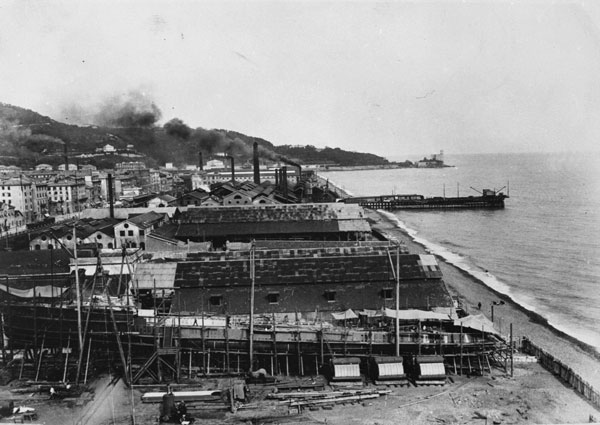
Ansaldo Sestri Ponente NyD
Naval Yards:
RN Delfino was built at La Spezia, which became the main naval yard for submarines. There, submarines were built at the main Royal naval yard and arsenal, or at the Fiat-San Giorgio facilities at Muggiano, Venice Naval Yard (a few ones), Ansado, Sestri Ponente (in Genoa) and Orlando Leghorn, Odero, Sestri and Vickers Terni (also at La Spezia). Odero, Fiat-St Giorgio and Orlando merged in 1927, giving the birth of OTO (Odero-Terni-Orlando), still a major European player in naval systems. A few submarines were also built at Tosi, in Taranto.
Contrary to the Royal Navy, the Japanese Navy, or Austro-Hungarians, Italy did not feel the need to purchase its first models abroad. The country had the engineers and know-how for a home-grown submarine technology. The only exceptions were a single model, RN Atropo, built in 1912 at Germaniawerft in Kiel when Italy was allied with the central Empires. She was ordered in 1911 with Italian specificities to test ideas as well as evaluating German technology at the time. The other exceptions were transfers from the entente power this time, of ‘W’, ‘S’ and ‘H’ types to bolster the submarine force during the war.
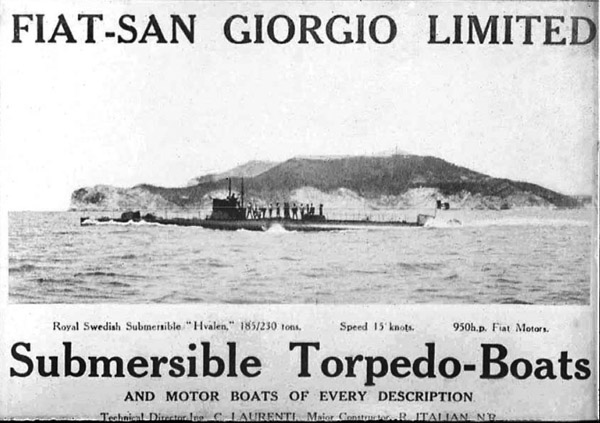
Fiat San Giorgio Yard in Muggiano, adverstising postcard showing Laurenti’s Hvalen. Src cultureimpresa.it odf about the muggiano yard
Powerplants
The Italians were less inclined to research underwater performances, choosing the more conventional approach of the French and Germans related to submarine design, meaning designing a submersible torpedo boat. Performances when submerged were inferior to that in surface, in a ratio generally of 12/8 knots, while electric power was at least 50% inferior to diesel power for surface operations. In general, FIAT was trusted with the diesel engines, while Ansaldo provided electric motors (or rarely, Savigliano). They were exceptions of course, diesels were also swapped for petrol engines, generally FIAT, but Thornycroft models were used on some boats, Atropo having Krupp diesels and AEG electric motors, or Velella or the Medusa class, MAN diesels, the Nautilus class Sulzer diesels. Tosi yard also rarely delivered diesels, in the case of the “N” class. The “B” class midgets of 1916 had an Itala petrol engine (standard from a car manufacturer) which basically was an auxiliary power as most of the power came from electric motors on the three midget classes (see later).
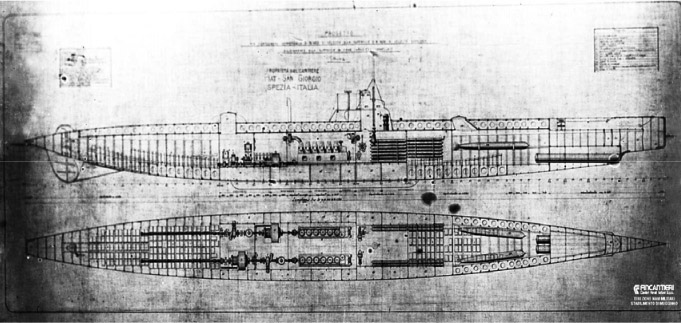
Plan of the Medusa in 1911, showing the location of the Diesels. Src
Cesare Laurenti, “father of Italian submarines”
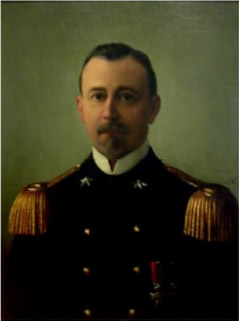 Special mention should be given to the designs of engineer Lt. Cdr. Cesare Laurenti.
Special mention should be given to the designs of engineer Lt. Cdr. Cesare Laurenti.
Major of the Naval Engineers, graduated in naval and mechanical engineering at the Royal Naval School of Genoa on 7 June 1892, Cesare Laurenti was assigned in 1903 to the Royal Arsenal of Venice. In 1892 he became the director of technical experiments for the first Italian submarine, Delfino, driven by a battery-powered electric motor, designed by Giacinto Pullino. His contribution to the design in 1902-1904 was to add a gasoline engine, allowing a large surface cruising range, recharging batteries while underway. A scheme which was novel at the time.
His first serial project was the Glauco class of 1903. His goal was to built the first Italian serie of operational submarines, although still semi-experimental in nature. They were not very successful, but this first step made Laurenti, which designed new submarines until well into the interwar a bit of the “Italian father of submarines”. With time, his models emphasises hull’s strength to dive deeper, which brought him to develop his trademark double hull design, now a staple of submarine construction for a century.
Laurenti was frequently sent abroad to study hulls and engines for submarines and became a “dottore” on the subject, having great influence over the design of Italian submarines during this era.
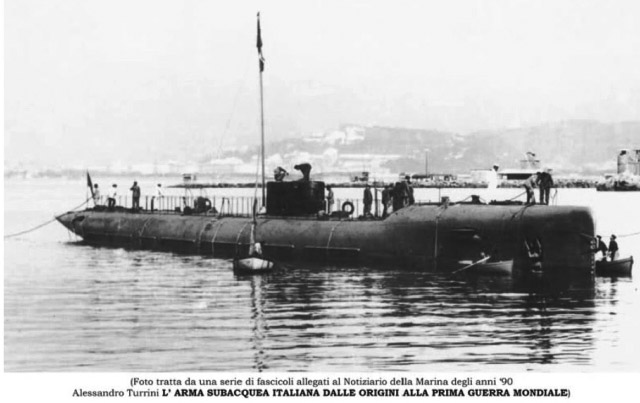
The submarine Ballila in 1915 Src
He had indeed dedicated himself with great passion to the studies of submarines since the 1890s. His lobbying for the construction of these models in the Regia Marina and frequent publications in naval reviews stimulated the officers of the Regia Marina into believing this new type of warfare and its promises. In 1905 he became the Technical Director at the Muggiano shipyard of La Spezia, designing the revolutionary Foca, the following Medusa class, the Argonauta and mass-built wartime F-class, well suited for the Adriatic. He also built some in UK, the latter taking the opportunity to test his designs (S class). Laurenti would also direct the construction of submarines sold to other navies, like the Japanese. Their main features were always a strong double hull, internal compartments and plenty of power. He for example designed in 1909-10 the USS G-4 for the US Navy.
Other engineers of the time were G. Pullino (Delfino’s engines), Virginio Cavallini (the largest Italian submarines), Edgardo Ferrati (Italian midgets) and Curio Bernardis, probably the most famous Italian submarine designer after Laurenti. He created notably the first Italian minelayer submarines, the X2 class, and went on designing a large part of Italian interwar models.
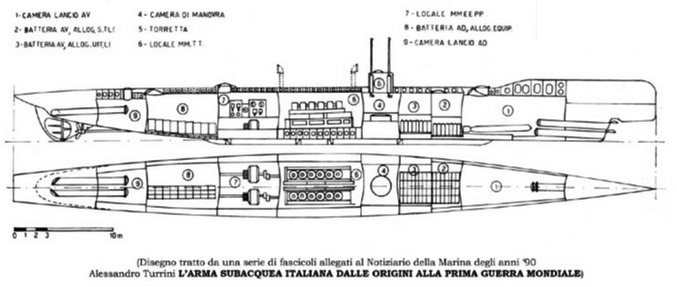
Blueprint of Balilla
Armament of Italian submarines
Deck guns became a thing only from the Pullino class in 1913, the most common during the war being a 76 mm/30 AA, placed aft on the deck. Exception to this were larger submarines, which had two of them, or mixed caliber. For torpedo tubes, these were invariably the 450 mm model (17.7 in), since the refit of the Delfino in 1902. When Italy started to built submersibles again in 1925, they swapped to the international caliber of 533 mm (21 inches), and bow and stern tubes.
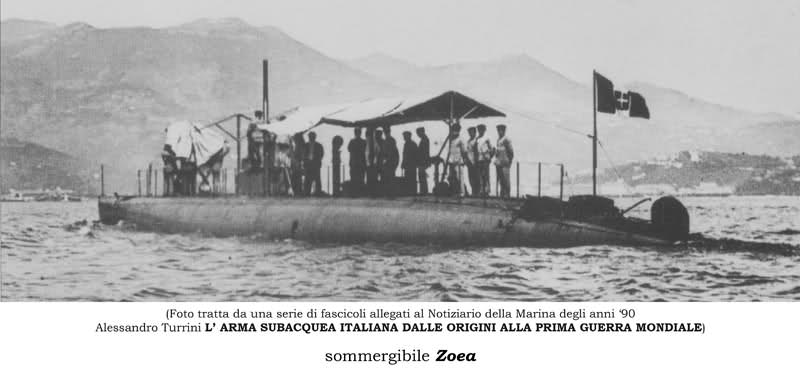
Submarine Zoea
Guns:
-3-inches/40 (76 mm)
-3-inches/30 AA (76 mm)
-57 mm (12 pdr)
-37 mm (6 pdr) both: Vickers Terni
Torpedoes:
-450 mm (17.7 in), standard for all Italian submarines
-356 mm (14 in) models (Delfino)
Read More/Src
Gardiner, Robert, Conway’s all the world’s fighting ship 1906-1921
http://www.hisutton.com/Mignatta.html
http://www.navweaps.com/Weapons/WTIT_List.php
https://www.treccani.it/enciclopedia/cesare-laurenti
http://www.navypedia.org/ships/italy/it_ss.htm
http://www.xmasgrupsom.com/Sommergibili/delfino1.html
https://en.wikipedia.org/wiki/List_of_submarines_of_Italy
http://www.betasom.it/forum/index.php?/topic/23615-classe-pacinotti-1914/
http://www.betasom.it/forum/index.php?/topic/35606-italian-q-ship-decoy-vessels/
http://www.grupsom.com/Sommergibili/F16..F18.html
http://www.sommergibili.com/pullino.htm
http://www.agenziabozzo.it/navi_da_guerra/C-Navi%20da%20Guerra/C-2640_R_Smg_Giacinto_Pullino_1913_sommergibile_in_prove_di_navigazione_nel_Golfo_della_Spezia.htm
Prewar Italian Submersibles
Delfino (1892)
The very first submersible of the Italian Navy. Dates are foggy about the laying down and launch. 1892 is the generally accepted date, or 1892-95, down to 1889-1890. Completion is certain, 1892. It was designed at first by Engineer Inspector Giacinto Pullino, the design was at first known as the “Delfino-Pullino”. Her sea trials took place in La Spezia Naval Yard (if records are right) on 29 April 1892, with a commission on the 1st of April (1896).
Whatever the case, she was given three propellers, one in the horizontal axis and two in the vertical. What is important is its design was completely modified by Cesare Laurenti in 1902. She was made shorter while a petrol engine was added for accelerate diving and surface navigation. Her kiosk was also enlarged, and she was rearmed, from two 14-in to the standard 17.7 in tube. Despite her experimental nature, she did served in WWI.

Delfino, after her refit in 1904.
Specifications:
-Displacement: 95/107 tons – Post-refit: 102/113 tons
-Dimensions: 24.6 x 2.8 x 2.7 m. – Post refit: 24 x 2.8 x 2.5 m.
-Machinery: One Electric motor. Post-refit: +1 shaft petrol motor. 130/65 bhp, 6/5 knots.
-Armament: 2x 14 in (356mm) TTs. Post-refit: 1x 17.7 in (450 mm) TT.
-Crew: 1 officer, 7 sailors. Post-refit: 2+8.
Glauco class (1905)
Glauco, Narvallo, Otria, Squalo, Tricheco
Small submarines designed by Cesare Laurenti, semi-experimental as some modifications were introduced along their construction. Notably their torpedo tubes: RN Glauco had three, the rest two. They were all built in Venice Navy Yard, launched between 1905 and 1909. They were given two shafts FIAT or Thornycroft for Otaria and Trichero. But in any case, these engines were not reliable and a source of danger. Emanations of petrol easy to ignite. For diving they had two Savigliano eletric motors combining 170 hp. They served for harbour defence at Brindisi and Venice and were discarded in 1916 (Glauco), and 1918 for the others.
![]()
Specifications:
-Displacement: 95/107 tons – Post-refit: 102/113 tons
-Dimensions: 24.6 x 2.8 x 2.7 m. – Post refit: 24 x 2.8 x 2.5 m.
-Machinery: One Electric motor. Post-refit: +1 shaft petrol motor. 130/65 bhp, 6/5 knots.
-Armament: 2x 14 in (356mm) TTs. Post-refit: 1x 17.7 in (450 mm) TT.
-Crew: 1 officer, 7 sailors. Post-refit: 2+8.
Foca (1908)
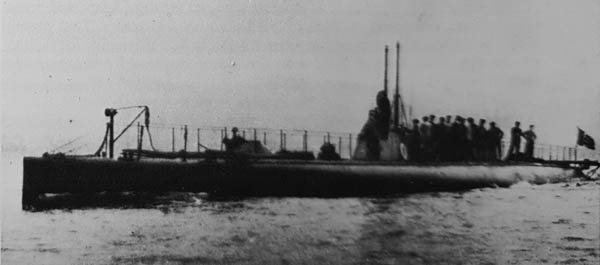
This unique submarine was designed by the FIAT-San Giorgio Yards, a development of the Glauco, and first submarine with three shafts and propellers and three sets of FIAT petrol engines for a total of 800 bhp, allowing a top speed of 16 knots, making her the fastest Italian submarine in service. She was launched on 8 September 1908. On 26 April 1909, she suffered an engine explosion which set fire on her fuel tank while testing its powerplant in Naples. The fire became so fierce she was deliberately sunk in the hope to recover her later. She was indeed refloated and towed to la Spezia she was repaired and the powerplant completely changed. The central shaft was eliminated and the new engines developed 600 hp for 160hp underwater, 12/6kts in surface/dive in 1910. This painful experience definitely ruled out pretol engines in the Regia Marina. Foca was in limited harbour service in WW1 and was discarded in 1918.
Specifications:
-Displacement: 185/280 tons – Post-refit: ?
-Dimensions: 42.5 x 4.2 x 2.6 m.
-Machinery: 3 shafts petrol 800 hp, 2 Siemens Electric motors 600/160 bhp, 16/6 knots.
-Armament: 2x 17.7 in (457mm) TTs.
-Crew: 2 officers, 15 sailors
Medusa class (1911)
Argo, Fisalia, Jalea, Jantina, Medusa, Salpa, Velella, Zoea.

Designed by Eng. Lt. Cdr. Cesare Laurenti at FIAT-San Giorgio yards, they were the first Italian diesel submarines. They required long trials for design adjustments and were built in various yards: Argo, Jalea, Medusa, and vevella in Fiat-San Giorgio, Fisalia and Zoea in Orlando, Leghorn and Salpa, jantina in Riuniti Yards in Muggiano. They were launched between May 1911 (Velella) and August 1913 (Jalea) and therefore had only a few month of training before WWI broke out. The first, Velella, had a provisional machinery: MAN diesels and Siemens electric motors. Until 1915 they had some more time for adjustments and constituted a true success, widely used during the war. They were very good seaboats including underwater, agility and stability. Jalea was sunk by a mine in the gulf of Trieste on 17.8.1915, while Medusa was sunk off Porto di Piave Vecchia in northern Adriatic by the German UB15, maskeraded as the Austrian submarine U11. Zoea was beached on 26 November 1917 by storm at Rimini, she was salvaged by the Tug Ciclope to be repaired and assisted by Italian TBs. She was towed to Venice in 1st Dec. to be repaired, and resuled service until 1918. Argo at the same time was converted as an assault submarine to fice Pola by using forgmen to cut out the nets and barrages at the entrance. All remainder subs were stricken in 1918.
Specifications:
-Displacement: 248-252 surf. 305 tons sub.
-Dimensions: 45.1 x 4.2 x 3 m.
-Machinery: 2 shafts FIAT diesels, 2 Savigliano electric motors. 650/300 bhp 12/8 kts
-Armament: 2x 17.7 in (450 mm) TT, 4 torpedoes
-Crew: 2-3 officers, 19 sailors.
Atropo (1912)
This single submarine was ordered in Germany, then an ally. German data was 237/318t, contractual speed was 12/7.3 kts and her pressure hull was very strongly built, making her the deepest-diving Italian submarine at that point. She also had a very good surface speed and a range to match. The Italians refined in particular her outer casing shape and lines very similar to a torpedo boat, as requested by the RN. Atropo was launched at Germaniawerft on 22.3.1912 and served actively during WW1, stricken in 1919.

Specifications:
-Displacement: 231 surf. 320 tons sub.
-Dimensions: 44.5 x 4.4 x 2.7 m
-Machinery: 2 Krupp diesels, 2 AEG Electric motors, 700/200 bhp, 14.75/8 kts, Range 1300 nm/12.5 kts or 40 underwater at 8 kts
-Armament: 2x 17.7 in (450 mm) TT, 4 torpedoes.
-Crew: 2 officer, 12 sailors.
Nautilus class (1913)
Nautilus, Nereide.
These were the first models designed by Engineer Lieutnant Commander Curio Bernardis, a well-known submarine designer in the interwar. He created torpedo-boats capable of diving under water basically, and originally they were to have three torpedo tubes, with one installed on the deck, but it was never mounted. Both were launched at Venice Naval yard in April and July 1913 and were in service when WWI broke out. Nereide service life was rather short: She was sunk on 7 August 1915 near Pelagosa island by the Austrian submarine U-5. Nautilus was discarded in 1919.

Specifications:
-Displacement: 225 surf. 320 tons sub.
-Dimensions: 40.9 x 4.3 x 2.7 m
-Machinery: 2 shafts Sulzer Diesels, 2 Ansaldo electric motor 13.2/8 kts
-Armament: 2x 17.7 in (450 mm) TT, 4 torpedoes.
-Crew: 2 officers, 17 sailors.
Pullino class (1913)
Giacinto Pullino, Galileo Ferraris.
These two boats built at La Spezia and launched in July and November 1913 were deigned by Eng. Lt. Cdr Virgilio Cavallini for deep-diving. They were able indeed to reach 50 m underwater and was strongly armed with six torpedo tubes and several guns. In fact they were the first Italian subs with deck guns. They were also the largest submarines, although still classed as “small submarines” (piccolo sottomarino). Giacinto Pullino was sunk on 1.8.1917. She ran aground during the night of 30 to 31 July 1916 at Gadiola island off Suarnaro, sabotaged by her crew as she was to be captured by the Austrians, she sank when in tow to Pola, and was raised on 28 February 1931 by the Italian Navy to be scrapped. Ferraris was beached during the night of 27-28 November 1917 at Magnavacca during a storm. She was salvaged in January 1918 but in such a poor state she was never repaired and stricken in 1919.
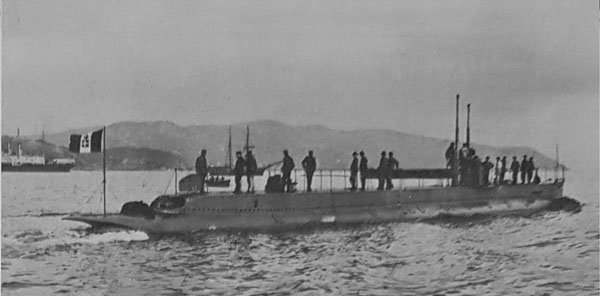
Specifications:
-Displacement: 345 surf. 405 tons sub.
-Dimensions: 42.2 x 4.1 x 3.7 m
-Machinery: 2 shafts FIAT diesel 2 Savigliano electric motors.
-Armament: 6 x 17.7 in (450 mm) TT, 2 bow, 2 stern, 2 external, 57 mm, 37 mm deck guns
-Crew: 2 officers, 19 sailors.
Argonauta (1914)
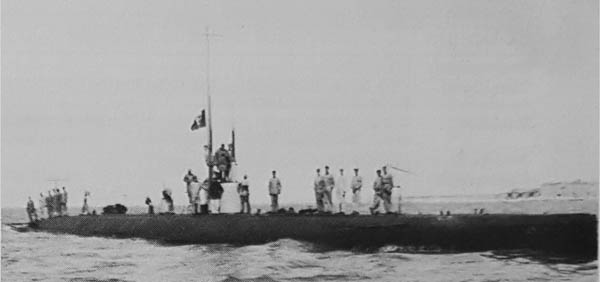
A single, small submarine designed by Cesare Laurenti at the FIAT-San Giorgio Yards, la Spezia. She was basically an improved Medusa, with additions requested by the Russian Navy which ordered her in 1912 as Svyatoy Georgi. Among others, she had a second periscope, better motors, retractable horizontal rudders, and a signalling gear. However after WWI broke out, a young Lieutenant took possession of the boat, just launched since July. By then she was called N°43 in the yard. The officer with a small group of volunteer intention was to sail her in the Adriatic and sinking Austrian shipping, whereas Italy was still neutral, hoping to force the country to war. As the boat was near Corsica she was stopped by French Authorities and escorted back to Italy. When the country entered the war she was purchased from the Russian government and renamed Argonauta. She served until 1928, quite a long service for a submarine of this generation.
Specifications:
-Displacement: 255 surf. 306 tons sub.
-Dimensions: 45.1 x 4.2 x 3 m
-Machinery: 2 shafts FIAT diesels, 2 Savigliano Electric motors 700/450 hp, 13.5/8.8 kts, range 950 nm/12 kts
-Armament: 2x 17.7 in (450 mm) TT, 4 torpedoes.
-Crew: 2 officers, 22 sailors.
Wartime Italian submersibles
F class (1916)
F-1 – F21.
This was the largest class of Italian submarines of the Regia Marina during the war. Small, coastal subs well suited for the adriatic as they could patrol over 1600 nautical miles, they were designed by Laurenti, built in part in San Giorgio yards in La Spezia, Orlando Leghorn and Odero Sestri. F1 was launched on 2.4.1916, F21 in May 1918. The yard previously built for the Brazilian Navy the F1-F5 launched in 1913-15 and the Regia Marina was pleased by the design and ordered a serie of 24 boats. They dive faster, had two periscopes, a gyrocompass, a Fessenden submarine signal gear, and a deckgun, 3-in (76 mm) 30 caliber AA but only carried four torpedoes. They were agile, and designed to prey on opportunity targets in points of known Austrian sorties.
Of the original order, F19-21 were sold to Portugal* and F-22-24 to Spain** while the RN ordered three boats in replacement, F19, 10, 21(ii). F8 sank in trials at La Spezia on 14 February 1917, refloated and back in service by September. F14 which was sunk, rammed by accident by the destroyer Missori during an exercize off Pola in 1928. She was raised and BU. All boats were stricken in the 1920s up to 1935.
*Foca, Golfinho, Hidra
**A1-A3 or Monturiol and Garcia

Specifications:
-Displacement: 262 surf. 319 tons sub.
-Dimensions: 45.6 x 4.2 x 3.1 .
-Machinery: 2 shafts FIIAT diesels, 2 Savigliano Electric motors.
-Performances: 670/500 bhp, 12.5/8.2 kts, oil 12 tons, range 1600 nm at 8.5 kts or 80 nm submerged
-Armament: 2x 17.7 in (450 mm) TT, 4 torpedoes, 1 x 76 mm/30 AA gun.
-Crew: 2 officers, 24 sailors.
S class (1915)
These were Italian-designed boats by Laurenti in San Giorgio Yds, built in UK. They were modified by Scott’s Shipbuilding & Engineering co. of Greenock. S1 was launched on 19.5.1915, followed by S2 in September, 20 and S3 on the 26. They repeated the design of the Argonauta with modifications. They served for a year in the Royal Navy before transfer for evaluation and were all stricken in 1919. Specifications as the British S class.
W class (1916)
W1 – W4.
Four boats designed by Arsmtrong Withworth at Newcastle on Tyne, all launched in August 1916 and transferred to Italy. After they were received, a 3-in gun/30 DP was added on their deck. They had poor manoeuvrability and their diesels were unreliable in service. This was the first pair, but the second had not such problems and was quite active in the Adriatic, making numerous war cruisers and sinking Austrian ships. W4 was lost presumably to a mine off cape Rodoni, 4-6 August 1917 and the remainder were stricken in 1919.
Specifications: As British W class, see WWI British subs page
H class (1916)
H1 – H8.
In total contrast to the former W class, these eight boats were ordered by the Italian government to the Electric Boat company of Montreal, Canada and were excellent boats, handy and reliable. This class was also en export success, used by numerous navies. They had very poerful eletric motors allowing for an excellent speed and agility underwater, a characteristic typical of these types. They were also the deepest-diving boats in the RN, at 80 m. It was generally about 50 m for most Italian-built models. but this was of little use in the shallow waters of the Adriatic. They were also fast-firing, able to fire two and reload two other torpedoes in five seconds. No deck gun in WWI but one was installed after the war which service was long and extensive, including WW2. H5 was sunk in error by HMS H1 in southern Adriatic and identification became “HB” for all, in particular for the British and French operating there.
Specifications as British H class. This career in WW2 is out of this scope, just mention H6 sank in Corsica by the Germans after the armistice and H8 by the Luftwaffe in La Spezia.
N class (1917)
N1 – N6.
Small submarines designed by Curio Bernardis, they were improved Nautilus, with a greater displacement, better powerplant, and a deck gun, 3 in/30 DP as usual. Six were built, the first four at Ansaldo, Sesttri and the remaining pair at Tosi in Tarento, some missing the end of the war, launched between September 1917 and September 1918. The Tosi boats were different, faster at 13.56 knots on surface, 7.94 knits underwater, and had a better radius of 750 nm at 12.5 knots, or 1485 nm at 9.5 knots and 17 nm submerged at 7.5 knots, 120 at 2 knots. Construction was slow due to the lack of material available and even more after the end of the war as they were no longer needed. They served until 1928-35.

Specifications:
-Displacement: 277 surf. 363 tons sub.
-Dimensions: 45.8 x 4.2 x 3.1 m
-Machinery: 2 Shafts diesel Sulzer, 2 electric motor.
-Armament: 2x 17.7 in (450 mm) TT, 1x 3-in AA
-Crew: 2 officers, 21 sailors.
X2 class minelayer subs (1917)
X1, ex UC1, X-1 – X-2
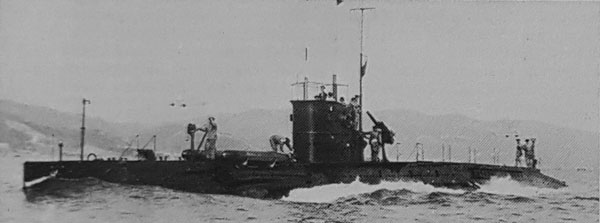
X3 as completed
The Italians operated an ex-German submarine during WWI: UC 12, a minelayer type from AG yard in Bremen, launched in December 1916, transferred to the Austrian navy as U24 with a German crew, ans sank on 16 march 1917 off Tarento, presumably hitting one of her own mines. She was raised by the Italian Navy and rebuilt/repaired in tarento Naval yard under the supervision of Bernardis, renamed X1. She was commissioned at the end of 1917 and served until the end of the war and was stricken in 1919.
Her particulars were: 171.2/184 tonnes, 33.6 x 3 x 2.7m, 1 shaft Sulzer diesel, Siemens-Schuckert eletric motor, 80-80/175 bhp, 6/4.5 knots, carryong 6 mine tubes for 12 mines and a 3-in deck gun.
This model led curio Bernardis to propose to the Italian admiralty copies of the design to mine the entrance of Pola. They were named naturally X2 and X3, built in Ansaldo Sestri and launched in April and December 1917 on a larger scale. The “X” signified “minelayer” as a denomination. The mine laying system was copied but the rest of the boat was mostly of Italian design. The mine compartment was enlarged, so she carried nine tubes (three more) for a total of 18 mines of the Italian AE1916/125t type. They also had a deck gun of the standard type and in 1918 were fitted with external cage TTs mounted on the main flooded trunk. They were however slow and lacked agility but stayed in service until 1940. They were both laid up on 16 September 1940.
Specifications:
-Displacement: 403 surf. 467 tons sub.
-Dimensions: 42.6 x 5.5 x 3.1 m
-Machinery: 2 shafts Sulzer diesels, 2 Ansaldo Electric motors
-Performances: 650/325 bhp, 8.2/6.3 knots
-Armament: 9x mines tubes, 18 mines, 3-in deck gun
-Crew: 2 officers, 20-23 sailors.
Alfa class Midget subs (1913)
Alfa, Beta.
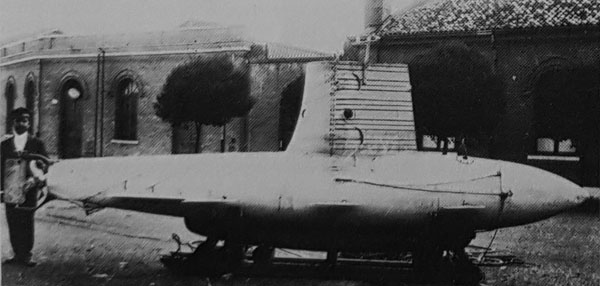
Small boats built in secret in Venice to survey and guard the harbour entrance. They eventually never entered official service after passing their sea trials. Both were built and launche din venice NyD in 1912-13. They were stricken in 1945-16.
Specifications:
-Displacement: ? circa 10 tons
-Dimensions: 6 m long, 76 cm diameter
-Machinery: 1 electric motor, 8 knots surface
-Armament: Unknown
-Crew: Unknown
A class midget subs (1915)
A1 – A6.
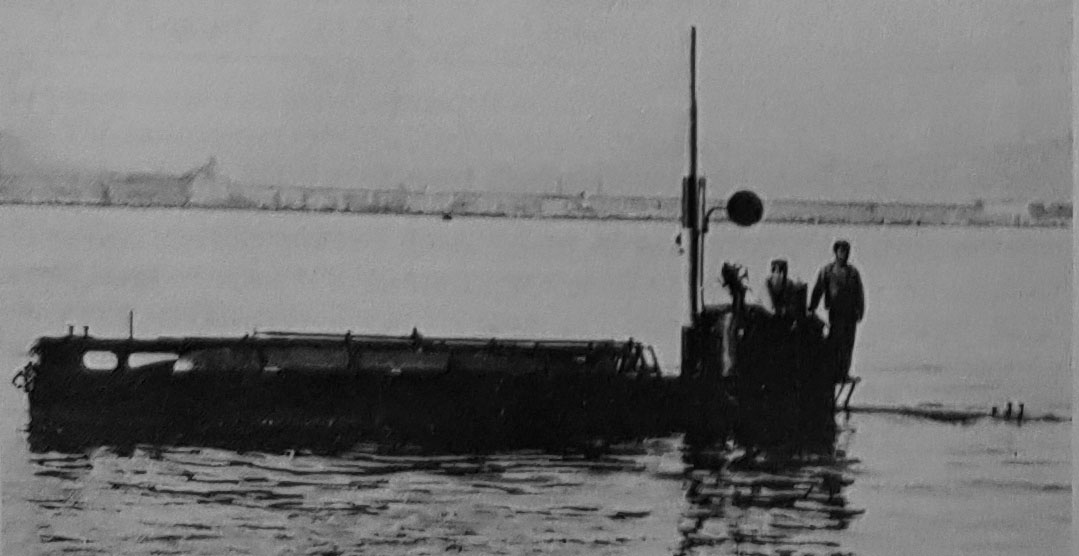
Small boats designed by Eng. Vice admiral Edgardo Ferranti a La Spezia NyD. They were made for the defence of Adriatic harbours such as Venice, Ancona and Brindisi and modular enough to be dismounted and transported by rail. As submarines however they were disappointing, slw and with a poor endurance, and fixed periscope. The class comprised the A1 (launched 17.1.1915) to A6 (11.2.1916), and all were stricken in 1918.
Specifications:
-Displacement: 31.2 surf. 36.7 tons sub.
-Dimensions: 13.5 x 2.2 x 2.3 m.
-Machinery: 1 electric motor 40/60 hp, 6.8/5 kts
-Armament: 2x 17.7 in (450 mm) TT in external cradles
-Crew: 1 officer, 3 sailors.
B class midget subs (1916)
A1 – A6.

This was an improvement of the A type, designed by Vice Admiral E. Ferrati and tesying two types of motors, one petrol and one electric in order to improve surface navigation and range. They were also given true hull-mounted tubes. Harbour defence types, with modular construction and rail-transportation capability. The class originally comprised B1 to B6 but the laest three were cancelled in 1917. B1 was launched in 8.7.1916 and B3 on 25.11.1916. They were discarded in 1919.
Specifications:
-Displacement: 40t surf. 45 tons sub.
-Dimensions: 15.1 x 2.3 x 2.5 m.
-Machinery: 1 Itala petrol engine, 1 Savigliano electric motor
-Performances: 85/40-60 hp, 6.9/5 kts range 28 nm 6.9 kts or 9 nm submerged.
-Armament: 2x 17.7 in (450 mm) TTs
-Crew: 1 officer, 4 sailors.
Micca class large subs (1917)
Pietro Micca, Angelo Emo, Luigi Galvani, Loerenzo Marcello, Lazzaro Mocenigo, Torricelli
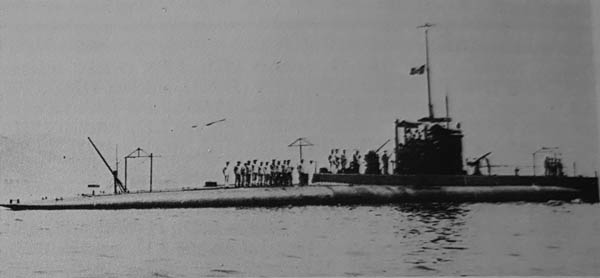
At some point during the war, the Admiralty expressed the need for larger submarines, since fro the beginning focus has been on cheap, small and coastal models well suited for the Adriatic. But in late 1916 the need for Mediterranean, long range and better armed models began to surface. This led to ahe creation of a committee for new ships in cooperation with the Engineer Liuetennant Virginio Cavallini to relaunch the construction of a 1914 project of large submarines. They were authorized in mid-1917 for the first, Pietro Micca, and five other will follow. Completion took time and even Micca was not operational when the war ended. None took part in operations, and construction dragged on due to the lack of resources in 1917. Galvani and Laorenze were launched in 1918, Marcello, Mocenigo and Emo in 1919. They were originally laid down in venice NyD in June 1914 but their hulls were dismantled and three new hulls laid down at La Spezia under the same names. They had six TTs, four in the bow, two in the stern, but two more were initially planned, placed on the deck on an external rotative mount like French TTs. They soon gained a poor reputation due to their unreliable FIAT diesels and lack of agility, but recoignised for their great endurance as planned. In 1923 they were partially rebuilt and modernized and stayed in service a few more years, between 1928 and 1937 (Mocenigo). Galvani still existed when WW2 broke out. She was mothballed at La Spezia, then towed to Leghorn to be dismantled in the summer of 1941.
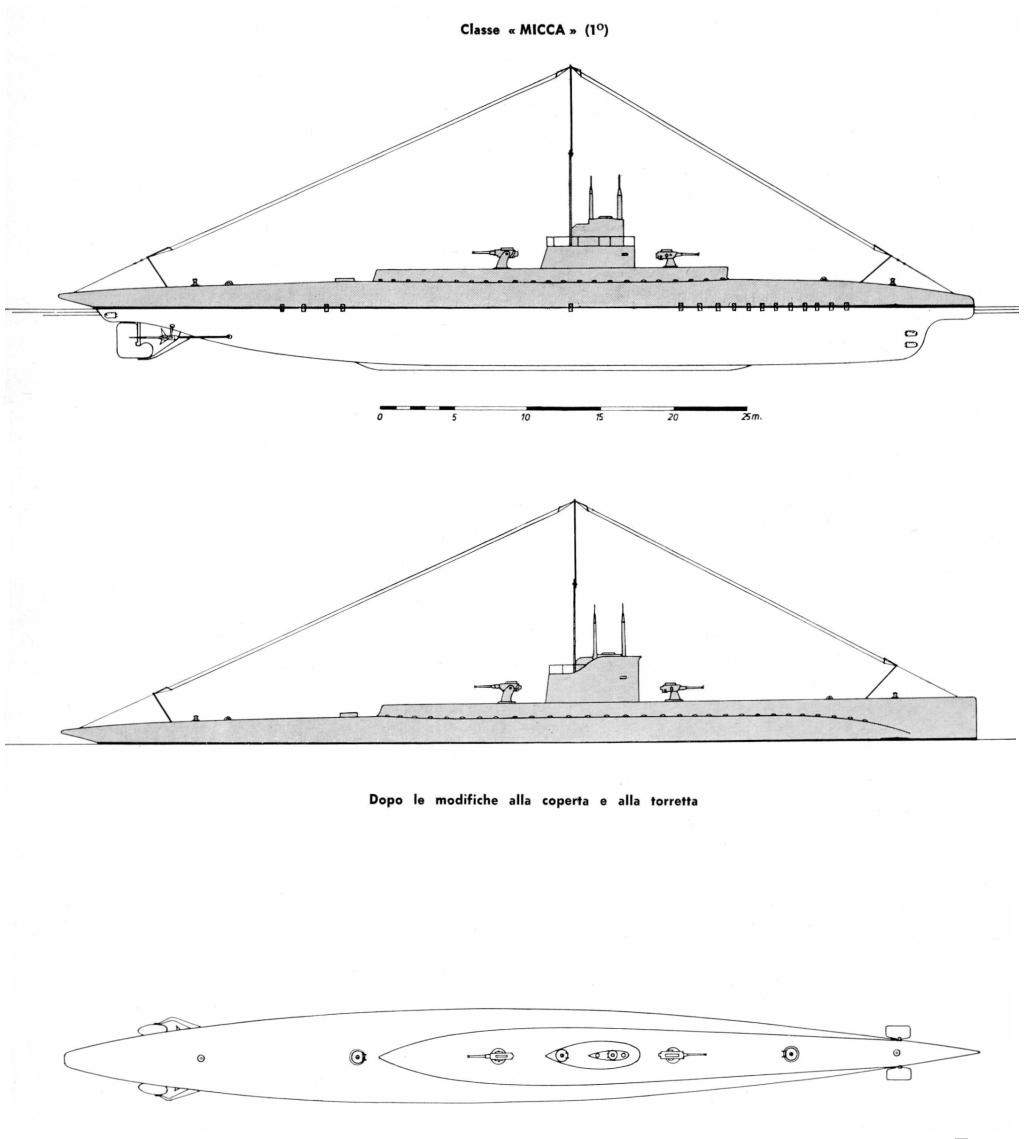
Appearance of the Pietro Micca – from da “I sommergibili italiani” di Paolo M. Pollina – USMM – 1963, per g.c. Sergio Mariotti. SRC
Specifications:
-Displacement: 842 surf. 1244 tons sub.
-Dimensions: 63.2 x 6.2 x 4.2 m.
-Machinery: 2 shafs FIAT(Tsi for Torricelli) diesels, 2 Ansaldo(or Savigliano) Electric motors.
-Performances: 2600-2900 bhp/1300-1800 bhp for 11kts/10.9 kts, oil 60 tons
-Armament: 6x 17.7 in (450 mm) TT, 1x 3-in/30, 1x 3-in/40
-Crew: 4 officers, 36 sailors.
Balilla Medium sub (1916)
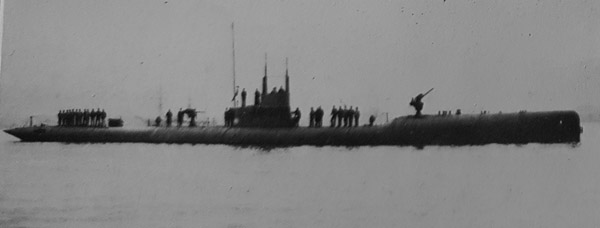
Ballila started as an order from the Germans before the war in 1913. The boat swould have been named U42 if delivered, but she was requisitioned during construction in June 1915 and launched in August at FIAT-San Giorgio Yard or La Spezia. She was given the powerplant later used for the larger Micca boats. Under her new name Balilla, she was one of the best design ever produced by the yard, ans also one which saw one of the most epic fighting action at sea during the war. RN ballila was sunk in the Adriatic, north west of the famous island of Lissa, during a surface artillery duel with the Austrian TBs 65F and 66F.
Specifications:
-Displacement: 728 surf. 875 tons sub.
-Dimensions: 65 x 6 x 4.1 m
-Machinery: As Micca, except 2600-1600/900 hp, 14/9 kts
-Armament: 4x 17.7 in TTs (2 bow, 2 stern, 7 torpedoes), 2x 3-in/30
-Crew: 4 officer, 34 sailors.
Pacinotti class submersibles (1916)
Pacinotti, Guglielmotti.
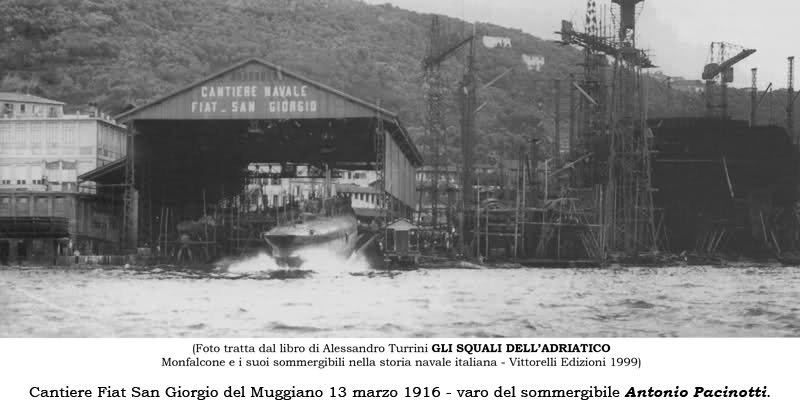
Launch of Pacinotti at the FIAT-San Giorgio Yard.
The requested German design interested the admiralty which decided to modify it for its own service. And so was born the Pacinotti class at the same yard in La Spezia. They had only three bow TTs (and two stern) but were generally similar to th U42/Ballila design. Both were launched in 1916, March (Pacinotti) and June (Guglielmotti). The latter during her maiden voyage was spotted by HMS Cyclamen, an ASW sloop, which took her for an U-Boat (undertandably). She was gunned and sunk NW of Carpaia island on 10.3.1917, and finished off by ramming. This went far beyond the occasional “friendly fire” and the British ship persisted on the poor boat, which crew was unable to prove its identity. The truth was discovered way later. Her sister ship Pacinotti did not stayed long in service, she was stricken in 1921, but considered overall a good boat. From 24 March to 4 September 1917 she operated in the northern Tyrrhenian Sea, to defend trade links routes in that area and carried out a total of 13 missions between La Maddalena, Livorno and Portoferraio, spending 926 hours at sea. On 7 September 1917, she was deployed to Sicily under orders of the island’s Marine Command. She was used for anti-submarine patrols, making ten missions along the coast of Lipari, Ustica, Palermo, Messina, Trapani and Favignana, operating together with the Malamocco, a large unarmed sail and steam boat of 300 GRT, acting as a bait for enemy subarines. On December 20, 1917 she returned to La Spezia, and undergone maintenance work lasting until February 1919. She was used for training at La Maddalena, from February to June 4, 1919.
See also (iT)

Specifications:
-Displacement: 710 surf. 869 tons sub.
-Dimensions: As Ballila
-Machinery: As Micca but 1100/900 bhp 14.6/10.24 kts, 3000 nm/12kts
-Armament: 5x 17.7 in (450 mm) TT, 2x 3-in/30.
-Crew: 4 officer, 35 sailors.
Provana class submersibles (1917)
Andrea Provana, Agostino Barbarigo, Giacomo nani, Sebastiano Veniero
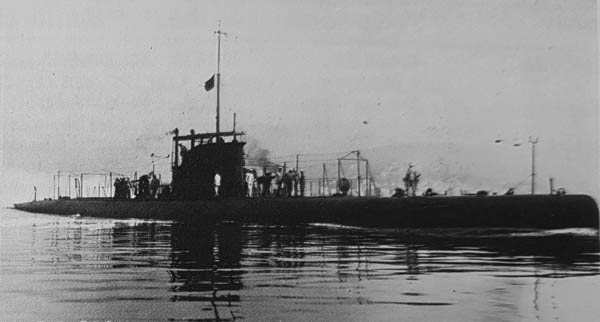
This class of medium to large boats (their almost reached 1,000 tonnes submerged) was the fruit of the collaboration between the celebrated engineer Laurenti and Lt. cdr Cavallini. The four boats were laid down in October 1915 but construction dragged one due to the lack of resources. They were launched between November 1917 (Barabrigo) and September 1918 (Nani) and completed after the war has ended. For the first time, they experimented a new management of batteries, in four watertight compartments under the horizontal deck than ran all the lenght of the vessel. They had quite a powerful powerplant and were ver fast for their day, reaching 10 knots submerged. They could dive to 50 m, but dive fast, and were agile underwater. Nevertheless, the design was not repeated in the interwar. They were discarded in 1925 (Veniero, sunk off Cape Passero due to a collision with SS capena), 1928 or 1935 (Nani). The Provana was not entirely scrapped as her conning tower section was saved and exhibited at the 1928 Turin naval show.
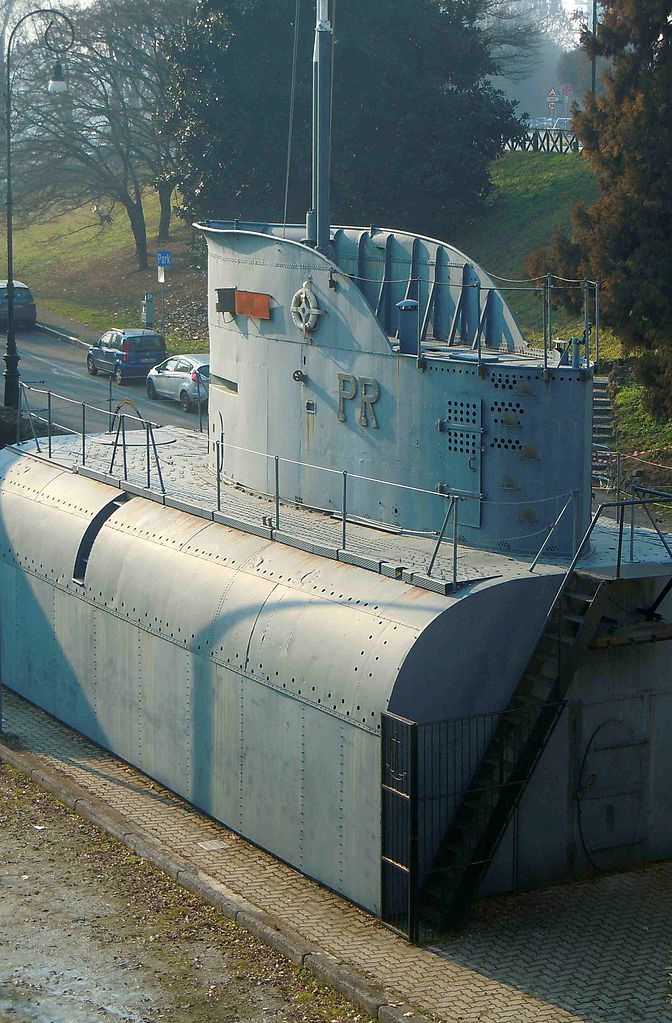
The Conning tower of the Provana, still preserved in Turin
Specifications:
-Displacement: 762 surf. 924 tons sub.
-Dimensions: 67 x 5.9 x 3.8 m
-Machinery: 2 FIAT diesels, 2 Ansaldo electric motors.
-Performances: 2600/1400 bhp, 16/9 knots
-Armament: 6x 17.7 in (450 mm, 8 torpedoes) TT, 2x 3-in/40
-Crew: 4 officers, 36 sailors.


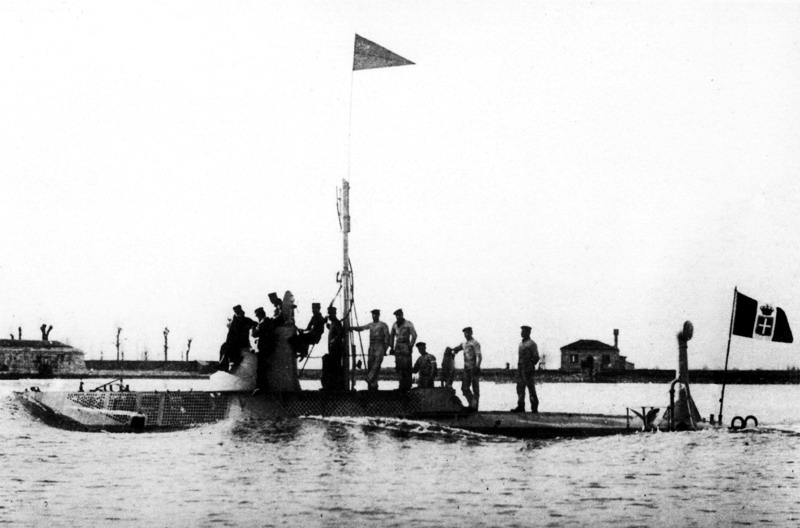
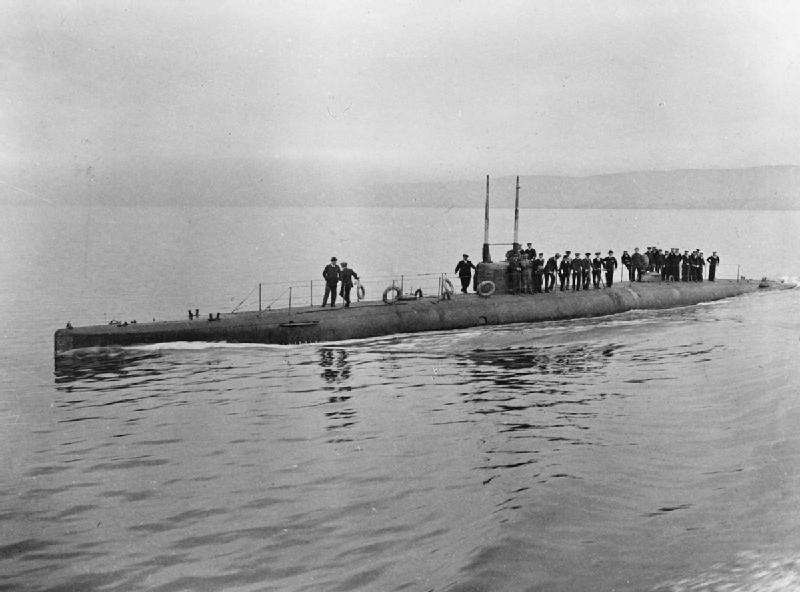
 Latest Facebook Entry -
Latest Facebook Entry -  X(Tweeter) Naval Encyclopedia's deck archive
X(Tweeter) Naval Encyclopedia's deck archive Instagram (@navalencyc)
Instagram (@navalencyc)





 French Navy
French Navy Royal Navy
Royal Navy Russian Navy
Russian Navy Armada Espanola
Armada Espanola Austrian Navy
Austrian Navy K.u.K. Kriegsmarine
K.u.K. Kriegsmarine Dansk Marine
Dansk Marine Nautiko Hellenon
Nautiko Hellenon Koninklije Marine 1870
Koninklije Marine 1870 Marinha do Brasil
Marinha do Brasil Osmanlı Donanması
Osmanlı Donanması Marina Do Peru
Marina Do Peru Marinha do Portugal
Marinha do Portugal Regia Marina 1870
Regia Marina 1870 Nihhon Kaigun 1870
Nihhon Kaigun 1870 Preußische Marine 1870
Preußische Marine 1870 Russkiy Flot 1870
Russkiy Flot 1870 Svenska marinen
Svenska marinen Søværnet
Søværnet Union Navy
Union Navy Confederate Navy
Confederate Navy Armada de Argentina
Armada de Argentina Imperial Chinese Navy
Imperial Chinese Navy Marinha do Portugal
Marinha do Portugal Mexico
Mexico Kaiserliche Marine
Kaiserliche Marine 1898 US Navy
1898 US Navy Sovietskiy Flot
Sovietskiy Flot Royal Canadian Navy
Royal Canadian Navy Royal Australian Navy
Royal Australian Navy RNZN Fleet
RNZN Fleet Chinese Navy 1937
Chinese Navy 1937 Kriegsmarine
Kriegsmarine Chilean Navy
Chilean Navy Danish Navy
Danish Navy Finnish Navy
Finnish Navy Hellenic Navy
Hellenic Navy Polish Navy
Polish Navy Romanian Navy
Romanian Navy Turkish Navy
Turkish Navy Royal Yugoslav Navy
Royal Yugoslav Navy Royal Thai Navy
Royal Thai Navy Minor Navies
Minor Navies Albania
Albania Austria
Austria Belgium
Belgium Columbia
Columbia Costa Rica
Costa Rica Cuba
Cuba Czechoslovakia
Czechoslovakia Dominican Republic
Dominican Republic Haiti
Haiti Hungary
Hungary Honduras
Honduras Estonia
Estonia Iceland
Iceland Eire
Eire Equador
Equador Iran
Iran Iraq
Iraq Latvia
Latvia Liberia
Liberia Lithuania
Lithuania Mandchukuo
Mandchukuo Morocco
Morocco Nicaragua
Nicaragua Persia
Persia San Salvador
San Salvador Sarawak
Sarawak Uruguay
Uruguay Venezuela
Venezuela Zanzibar
Zanzibar Warsaw Pact Navies
Warsaw Pact Navies Bulgaria
Bulgaria Hungary
Hungary

 Bundesmarine
Bundesmarine Dutch Navy
Dutch Navy Hellenic Navy
Hellenic Navy Marina Militare
Marina Militare Yugoslav Navy
Yugoslav Navy Chinese Navy
Chinese Navy Indian Navy
Indian Navy Indonesian Navy
Indonesian Navy JMSDF
JMSDF North Korean Navy
North Korean Navy Pakistani Navy
Pakistani Navy Philippines Navy
Philippines Navy ROKN
ROKN Rep. of Singapore Navy
Rep. of Singapore Navy Taiwanese Navy
Taiwanese Navy IDF Navy
IDF Navy Saudi Navy
Saudi Navy Royal New Zealand Navy
Royal New Zealand Navy Egyptian Navy
Egyptian Navy South African Navy
South African Navy






























 Ukrainian Navy
Ukrainian Navy dbodesign
dbodesign
Just wanted to say that this page is beautifully laid out! It’s as if you picked up a book. Well done!
Thanks Bob !
It can and will be further improved.